
Italian postcard by B.F.F. Edit. (Casa Editrice Ballerini & Fratini, Firenze), no. 755. Giacomo Puccini (1858-1924) was an Italian opera composer, considered among the greatest, of the late 19th and early 20th centuries. He was a visionary and creator of the concepts that would govern cinema during the 20th century. His third opera, 'Manon Lescaut' (1893), was a success and brought him into contact with librettists Luigi Illica and Giuseppe Giacosa, who collaborated with him on his next three operas. The first of these, 'La bohème' (1896), is considered one of his best works and also one of the most romantic operas of all time. His next opera, 'Tosca' (1900), was Puccini's first foray into verismo, the naturalistic style in literature and opera. 'Madame Butterfly' (1904) was based on a play by David Belasco. This opera received a very hostile reception at its premiere. That criticism was largely orchestrated by rivals of Puccini. After several revisions, it became one of his most successful operas.
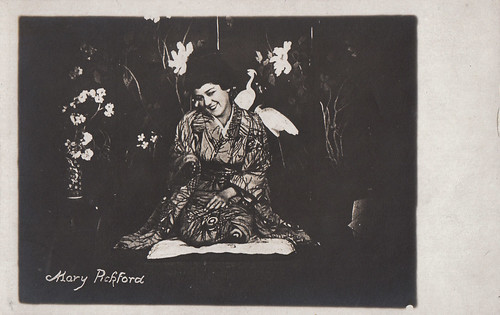
Vintage postcard. Mary Pickford as the Japanese character Cho-Cho-San in Madame Butterfly (Sidney Olcott, 1915). Collection: Marlene Pilaete.

Italian postcard by G.B. Falci, Milano, no. 300. Photo: Leda Gys as Mimì in La Bohème (Amleto Palermi, 1917).

Spanish postcard by Amattler Marca Luna. Series 5, no. 18. Photo: Caesar Film. Francesca Bertini as Floria Tosca, Gustavo Serena as Mario Cavaradossi, and Alfredo De Antoni as Baron Scarpia in the Italian silent film Tosca (Alfredo De Antoni, 1918). The execution of Cavaradossi on the roof of the Castel Sant' Angelo, with St Peter's cupola in the distance. Tosca discovers Scarpia's betrayal. She has just stabbed Scarpia to death. When Scarpia's men try to arrest her, she jumps off the roof with the words: "O Scarpia, Avanti a Dio!"

Spanish postcard by Amattler Marca Luna chocolate, series 7, no. 18. Lyda Borelli in Carnevalesca (Amleto Palermi 1918), after Lucio d'Ambra. Photography was by Giovanni Grimaldi. Maria Teresa discovers she has killed the man she loved while he was innocent. Just as with the dead Scarpia in Puccini's opera 'Tosca' and the preceding play by Sardou performed by Sarah Bernhardt, candles are placed next to the dead person.

Spanish collector card in the Escenas selectas de cinematografia series. Maria Jacobini in La Bohème/ Boheme - Künstlerliebe (Gennaro Righelli, 1923), based on the novel by Henri Murger, which later was turned into an opera by Giacomo Puccini.

Italian postcard by Ballerini & Fratini, Firenze, no. 282. Photo: Metro-Goldwyn, Rome. Renée Adorée in La Boheme (King Vidor, 1926). Collection: Marlene Pilaete.
Puccini in the Italian silent film
If one consults the Internet Movie Database, it seems that in the silent era, only three Brazilian shorts of 1908-1909 were based on Giacomo Puccini’s operas. Many silent films were based on the sources for Puccini’s operas such as Victorien Sardou’s play 'Tosca' (1887). Another example (1887) is 'Scènes de la vie de bohème' (1849) by Henry Murger. And don't forget 'L’Histoire du chevalier des Grieux et de Manon Lescaut' (1731) by Abbé Prévost.
Puccini's 'Madame Butterfly' was based on a short story (1898) by John Luther Long, which was turned into a stage play (1900) by David Belasco, which in return inspired Puccini for his opera. Thus, to avoid any copyright problems, and being unable to recreate the voices and orchestras from the opera, filmmakers relied on the literary and theatrical sources for the operas, using their plots, but staging them with different means.
It may not come as a surprise that Italy produced several films based, directly or indirectly on Puccini’s operas, such as the 1918 version of Tosca with Francesca Bertini, which would be one of Bertini’s most popular films worldwide. Her regular co-star of the 1910s, Gustavo Serena, played Cavaradossi, while Alfredo De Antoni directed.
Exceptionally, Puccini’s music was played at the premiere of the film, with the consent of Giacomo Puccini’s musical agent Ricordi. Unfortunately, only a fragment of the film remains, but we do have a large card series. In the documentary, L’ultima diva/The Last Diva (1982) by Gianfranco Mingozzi, Bertini, in her nineties, re-enacts her dying scene at the end of Tosca, when her character commits suicide by jumping from the Castel Sant’Angelo.
Yet, this film version of 'Tosca' was preceded by a short version by André Calmettes, filmed in 1908 and starring Sarah Bernhardt, for whom Sardou had written the stage play. Also, in 1911 Dutch film director Theo Frenkel filmed in Great Britain a version of 'Tosca', in which the actress Lillian Russell debuted on screen. A reference to the death of Scarpia in 'Tosca' was made in Amleto Palermi’s film Carnevalesca (1918), starring Lyda Borelli as Queen Maria Teresa, who has unjustly stabbed her newlywed husband. Just as with the death of Scarpia in Puccini's opera 'Tosca' and the preceding play by Sardou as performed by Sarah Bernhardt, candles are placed next to the dead person.

French postcard by A & S (Saint-Just), Paris, no. 903/8. Caption: Tosca has just killed Baron Scarpia. From a series of staging moments in the play by Sardou and the opera by Puccini. In the 1900s, publisher A.S./ Saint-Just made several staged, coloured postcard series based on operas and operettas such as 'Faust', 'Manon Lescaut', 'Carmen', 'Cavalleria rusticana', 'Die schöne Galathée' (presented as 'Galathée et Pygmalion'), 'La fille du régiment', 'Pippo et Bettina', 'La fille de Madame Angot' and 'Le passant'. There were also series based on books such as 'Paul et Virginie', and plays such as 'Cyrano de Bergerac' and 'Madame Sans-Gène'.

Italian postcard in the series La Voce del Padrone (HMV). Portrait: Nanni. Tenor Antonio Cortis as the painter Mario Cavaradossi in the opera 'Tosca' by Puccini. Hear him sing the famous aria' E lucevan le stelle' from Tosca here (recording of 1929) on YouTube.

German postcard by GG Cie, no. 5050. Geraldine Farrar as Madame Butterfly.
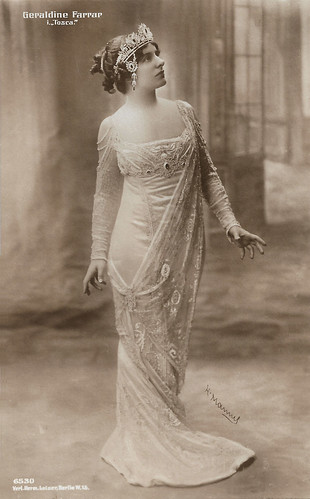
German postcard by Verlag Herm. Leiser, Berlin, no. 6530. Photo: H. Manuel. Geraldine Farrar in the opera 'Tosca'.
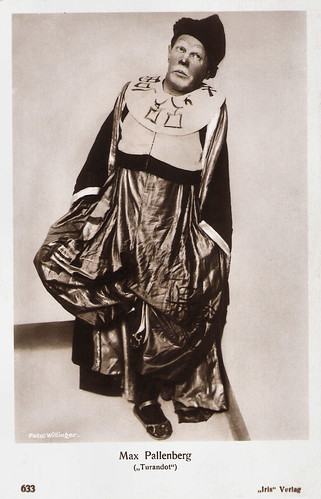
Austrian postcard by Iris Verlag, no. 633. Photo: Laszlo Willinger. Under the direction of Max Reinhardt, Max Pallenberg played Traffaldino in 'Turandot' (1926) by Giacomo Puccini at the Salzburger Festspiele.

French postcard by Cinémagazine-Edition, no. 572. Photo: Freulich / First National. Colleen Moore as Madame Butterfly. The photo was specially posed for Motion Picture magazine in 1928.
Puccini in Hollywood
Hollywood also discovered Puccini as a source for silent films. In 1915, Mary Pickford starred opposite future film director Marshall Neilan as Lt. Pinkerton in Famous Players’ version of 'Madame Butterfly', directed by Sidney Olcott. The film was shot in a Chinese garden in Plainfield, New Jersey.
In Germany, Fritz Lang filmed a variation on the 'Madame Butterfly' plot as Harakiri (1919). While the film’s story has a preceding plot, halfway the film’s plot becomes the familiar one about a young Japanese woman abandoned by her lover, a European navy officer. She gives birth to their son in his absence and faithfully awaits his return. When he returns after four years, he is accompanied by his European wife. Lil Dagover played the lead.
Three major adaptations of 'La Bohème' were filmed in the silent era, in Italy, in Germany, and in the United States. Firstly, the Italian version was filmed in 1917 by Amleto Palermi, starring Leda Gys as Mimí and Luigi Serventi as Rodolphe.
In Germany, Italian director Gennaro Righelli, who had fled Italy after its film crisis in the early 1920s, directed Bohème a.k.a. Künstlerliebe (1923), starring Righelli’s lover Maria Jacobini as Mimí and Walter Janssen as Rodolphe. Serventi also joined, but now as Count Paul.
The most famous adaptation was the American film La Bohème (1926) by King Vidor, who gave the female lead to Lillian Gish and selected John Gilbert as Rodolphe. According to IMDb, John Gilbert was so infatuated with Gish that he would mess up his love scenes, so he could kiss her over and again. A review on IMDb indicates the strong emotional performance by Gish but also Vidor’s focus on her face as a strong asset of the film.

Italian postcard by G.B. Falci, Milano, no. 307. Leda Gys as Mimì in La Bohème (Amleto Palermi, 1917).

Italian postcard by Ed. Vettori, Bologna. Francesca Bertini als Tosca and Alfredo De Antoni as baron Scarpia in Tosca (Alfredo De Antoni, 1918).

Spanish postcard by Gurgui, no. 11. Gustavo Serena as Mario Cavaradossi in Tosca (Alfredo De Antoni, 1918).

Spanish postcard by Amattler Marca Luna. Series 5, no. 1. Photo: Caesar Film. Francesca Bertini as Floria Tosca in Tosca (Alfredo De Antoni, 1918). Francesca Bertini as Tosca, in a citation of the famous portrait of Madame Récamier by J.L. David.
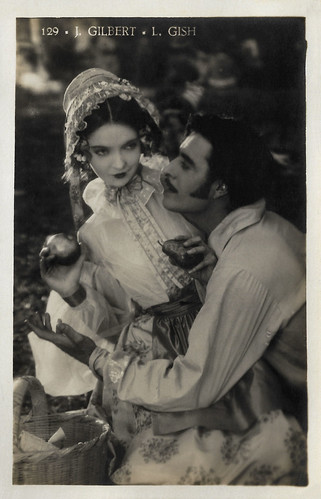
Italian postcard by Fotocelere, no. 129. Photo: Metro-Goldwyn-Mayer (MGM). Lillian Gish and John Gilbert in La Bohème (King Vidor, 1926). After 13 years with D.W. Griffith, Lillian Gish moved to MGM where her first picture was La Bohème (1926).

Italian postcard by Casa Editrice Ballerini & Fratini, Firenze (B.F.F.), no. 199. Photo: Metro-Goldwyn, Roma (MGM). Lillian Gish in La Bohème (King Vidor, 1926).

Italian postcard by G.B. Falci, Milano, no. 129. Photo: A. Stefano Pittaluga. Lya de Putti and Vladimir Gajdarov in Manon Lescaut (Arthur Robison, 1926), based on the oft-filmed novel by Abbe Prevost. It was produced and distributed by German film company Universum Film AG better known as Ufa. A young actress named Marlene Dietrich had a supporting role in this production and showed her later famous legs.
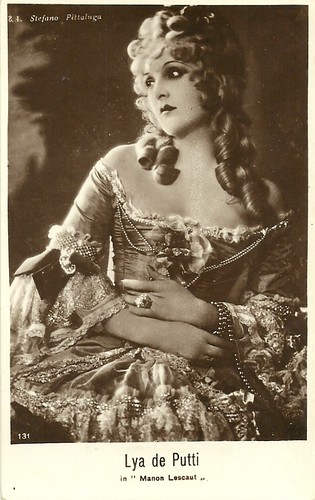
Italian postcard by G.B. Falci, Milano, no. 131. Photo: A. Stefano Pittaluga. Lya de Putti in Manon Lescaut (Arthur Robison, 1926).

Torre del Lago, statue of Giacomo Puccini by Paul Troubetzkoy. Photo by Ivo Blom. Troubetzkoy's original statue (1925), quite small actually, can be viewed at the Museo Villa Puccini in Torre del Lago. From 1891, Puccini often spent time at Torre del Lago near Viareggio, where he built his Villa in 1900 and lived until 1921. An annual Puccini festival is now held at Torre del Lago, while his villa has become a museum.
Sources: Le Giornate del Cinema Muto (Italian), Jbill-74877 (IMDb), Wikipedia and IMDb.
No comments:
Post a Comment